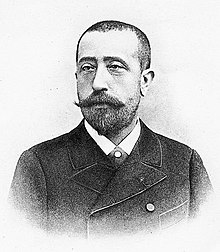
Back Tourettesindroom Afrikaans متلازمة توريت Arabic Síndrome de Tourette AST Turet sindromu Azerbaijani Синдром на Турет Bulgarian Touretteov sindrom BS Síndrome de Tourette Catalan Touretteův syndrom Czech Tourettes syndrom Danish Tourette-Syndrom German
| Tourette syndrome | |
|---|---|
| Other names | Tourette's syndrome, Tourette's disorder, Gilles de la Tourette syndrome (GTS), combined vocal and multiple motor tic disorder [de la Tourette] |
 | |
| Georges Gilles de la Tourette (1857–1904), namesake of Tourette syndrome | |
| Specialty | Pediatrics, neurology, psychiatry[1] |
| Symptoms | Tics[2] |
| Usual onset | Typically in childhood[2] |
| Duration | Long term[3] |
| Causes | Genetic with environmental influence[3] |
| Diagnostic method | Based on history and symptoms[2] |
| Medication | Usually none, occasionally neuroleptics and noradrenergics[2] |
| Prognosis | 80% will experience improvement to disappearance of tics beginning in late teens[3] |
| Frequency | About 1% of children and adolescents[4] Between 0.3% and 1.0% of general population[5] |
Tourette syndrome or Tourette's syndrome (abbreviated as TS or Tourette's) is a common neurodevelopmental disorder that begins in childhood or adolescence. It is characterized by multiple movement (motor) tics and at least one vocal (phonic) tic. Common tics are blinking, coughing, throat clearing, sniffing, and facial movements. These are typically preceded by an unwanted urge or sensation in the affected muscles known as a premonitory urge, can sometimes be suppressed temporarily, and characteristically change in location, strength, and frequency. Tourette's is at the more severe end of a spectrum of tic disorders. The tics often go unnoticed by casual observers.
Tourette's was once regarded as a rare and bizarre syndrome and has popularly been associated with coprolalia (the utterance of obscene words or socially inappropriate and derogatory remarks). It is no longer considered rare; about 1% of school-age children and adolescents are estimated to have Tourette's,[2] though coprolalia occurs only in a minority. There are no specific tests for diagnosing Tourette's; it is not always correctly identified, because most cases are mild, and the severity of tics decreases for most children as they pass through adolescence. Therefore, many go undiagnosed or may never seek medical attention. Extreme Tourette's in adulthood, though sensationalized in the media, is rare, but for a small minority, severely debilitating tics can persist into adulthood. Tourette's does not affect intelligence or life expectancy.
There is no cure for Tourette's and no single most effective medication. In most cases, medication for tics is not necessary, and behavioral therapies are the first-line treatment. Education is an important part of any treatment plan, and explanation alone often provides sufficient reassurance that no other treatment is necessary.[2] Other conditions, such as attention deficit hyperactivity disorder (ADHD) and obsessive–compulsive disorder (OCD), are more likely to be present among those who are referred to specialty clinics than they are among the broader population of persons with Tourette's. These co-occurring conditions often cause more impairment to the individual than the tics; hence it is important to correctly distinguish co-occurring conditions and treat them.
Tourette syndrome was named by French neurologist Jean-Martin Charcot for his intern, Georges Gilles de la Tourette, who published in 1885 an account of nine patients with a "convulsive tic disorder". While the exact cause is unknown, it is believed to involve a combination of genetic and environmental factors. The mechanism appears to involve dysfunction in neural circuits between the basal ganglia and related structures in the brain.
- ^ Müller-Vahl KR, Szejko N, Verdellen C, et al. (July 2021). "European clinical guidelines for Tourette syndrome and other tic disorders: summary statement". Eur Child Adolesc Psychiatry. 31 (3): 377–382. doi:10.1007/s00787-021-01832-4. PMC 8940881. PMID 34244849. S2CID 235781456.
- ^ a b c d e f g Stern JS (August 2018). "Tourette's syndrome and its borderland" (PDF). Pract Neurol (Historical review). 18 (4): 262–270. doi:10.1136/practneurol-2017-001755. PMID 29636375. Archived (PDF) from the original on December 1, 2018. Retrieved November 30, 2018.
- ^ a b c "Tourette syndrome fact sheet". National Institute of Neurological Disorders and Stroke. July 6, 2018. Archived from the original on December 1, 2018. Retrieved November 30, 2018.
- ^ Cite error: The named reference
Holliswas invoked but never defined (see the help page). - ^ Cite error: The named reference
EuropeanPartIwas invoked but never defined (see the help page). - ^ Cite error: The named reference
PringHoller2019was invoked but never defined (see the help page).
© MMXXIII Rich X Search. We shall prevail. All rights reserved. Rich X Search